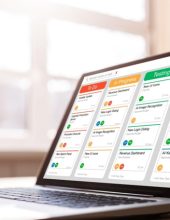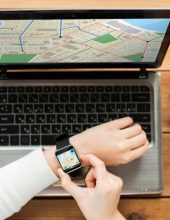Some designers of new services do not realize how great a source of inspiration and advancement of Design Thinking can come from developing countries. Countries of Africa, not usually associated with technological development, boast a surprisingly high level of sophistication in mobile services, especially mobile payments.
Not long ago, we witnessed the launch of payments using Near Field Communication (NFC) technology in Poland. As the European leader in contactless payments, Poland was a test field for this technology. NFC arouses a lot of excitement and expectations, but interestingly, the use of mobile in payments is not a new idea. The pioneer and leader in this area is a country very rarely associated with such innovation. Kenya – a country where a service called M-PESA has been in use since 2007.
You can learn more about the M-PESA banking application project from this article.
Design thinking: discover the real problem
The key turned out to be discovering the real problem from the customer’s perspective. East Africans’ big problems have become their opportunities. What is not always the general rule, these have been put to good use.
Conditions in Kenya in 2007, may have seemed unpromising for the development of electronic services:
- Few Kenyans owned computers.
- Even fewer had access to the Internet.
- Ownership of a bank account was rare, especially in rural areas (In 2009, only 19% of adult Kenyans had a bank account).
- The network of ATMs and bank branches was poorly developed. If one already had a bank account, the nearest ATM was miles (or tens of miles) away from where one lived.
Design thinking: UX & market research
On the other hand, a positive feature of the market turned out to be the fast-growing mobile network, which became the foundation of the newly emerging service.
The demand for a new way of transferring money in Kenya resulted indirectly from the country’s poor economic situation. This caused the migration of the population from rural to urban areas. Then the challenge arose of how to transfer the money earned to the families who stayed back home. There were 3 possibilities:
- Giving money to people who were going to the workers’ hometowns.
- Using bus drivers and matatu (collective cabs).
- Sending money by mail.
The first two ways were risky, as money often did not reach its destination. The post office, on the other hand, operated inefficiently and irregularly. In 2007, Safaricom, East Africa’s largest mobile operator, came to the rescue and launched a service called M-PESA.
Design thinking: solution
The main advertising slogan for the newly launched service was “Send money home”. Simple and clear communication was key in the country where most of the population did not understand what cashless money transfers were. M-PESA (“Pesa” means “money” in Swahili) made it possible to send a certain amount of money using a cell phone to another phone owner, not necessarily registered in the system.
In addition to sending money to loved ones, M-PESA customers can with the phone also:
- pay bills,
- check their account balance,
- take a loan,
- make cash deposits and statements with authorized agents,
- debit their phone,
- pay for an airline ticket (the system is honoured not only by Kenya Airways but also by British Airways and Virgin Atlantic).
Each functionality is a response to the needs of the market, resulting in a system that is simple and tailored to the needs of users.
The M-PESA application is very simple to use. The ascetic interface design is influenced by the devices Kenyans use. These are older-generation phones, which do not yet have, among other things, built-in touch screens, Internet access or other functionalities that smartphones we are familiar with have. Kenyans mostly use phones that were widespread in Europe a dozen years ago.
What’s more, the application has a very simple information architecture. All its elements are the bare minimum, which guarantees efficient and intuitive operations.
M-PESA application expansion
In 2012, about $61 billion was transferred in Africa using cell phones. This is a larger sum than the aggregate transfers made via this method in Europe and the US. By last year, M-PESA, had about 17 million registered users in Kenya. In addition to its home country, the service has also been introduced in other developing countries such as Tanzania, and South Africa.
M-PESA effects
On its tenth anniversary, M-PESA was serving 30 million customers across 10 countries. Today, 96% of households outside the Kenyan capital of Nairobi have at least one M-PESA account.
Studies have found that households using M-PESA are better able to withstand sudden declines in income because they can more easily receive remittances and are saving more money. Moreover, M-PESA lead to the financial empowerment of women and helped them gain control over their income. This translated into some women graduating from agriculture into more productive jobs.
The adoption of M-PESA has had a tremendous effect on Nairobi’s startup scene. Over the past few years, the startup ecosystem in Nairobi grew very actively with business models building on M-PESA’s foundations. Kenyan startups raised a total of US$32.8 million in 2017, according to the most recent African Tech Startups Funding Report, the third largest amount raised by any one country on the continent. There are now 38 fintech start-ups active in Kenya.
M-PESA has connected tens of millions of customers with access to financial services, contributing to a more than three-fold growth in formal financial inclusion across Africa. It has equally transformed the standard of living in rural areas and empowered women with access to and control over their finances. Tapped by many to power the digital economy, M-PESA has contributed to youth empowerment through entrepreneurship, especially in e-commerce.
The phenomenal growth
The phenomenal growth of M-PESA is a beautiful example of how technology can promote financial inclusion and alter people’s lives for the better. The increasing demand for mobile money services has allowed M-PESA to develop while encountering difficulties in certain areas. Expanding into new regions, M-PESA is poised to play an even more significant part in helping individuals overcome economic barriers and realize their aspirations.
Socioeconomically, M-PESA has provided a lifeline for millions of people facilitating direct disbursements from governments and non-government organizations to refugees, patients accessing health care, and economically vulnerable persons amongst other groups.
M-PESA itself has also contributed to the rapid growth of other companies producing digital services and has greatly accelerated the development of start-ups in Africa, precisely in the regions with the most users of the app.
Conclusions
M-PESA case shows how to create a good business. In the simplest sense, use the data, care about others’ feelings and transform experiences. And in practice? By implementing Design Thinking Strategy which aims to collect and analyze data, “listen” to the 3 voices (customer, market and business) and then create a joint value proposition. As the M-PESA case shows the winners are the organizations that engage stakeholders, employees and customers in the very early stages of the service development process. With the tested practices, they can solve the right problem from the customer’s perspective.
M-PESA itself has contributed to the rapid growth of other companies producing digital services and has greatly accelerated the development of start-ups in Africa, precisely in the regions with the most users of the app.
The people of Africa, despite their lack of access to the latest technologies and devices, are forerunners in mobile trends. For this reason, it is worth looking at new mobile solutions on the continent when designing services.
In the article, I focused only on describing the application used in mobile banking. However, while collecting materials, I repeatedly came across examples of other services, such as automotive, energy and health care, which are also worth a closer look. The success shows that Africa can play an important role in the development of modern mobile services and shaping patterns for good design thinking practices.
















Leave a comment